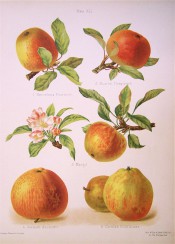Malus domestica Borkh.
The Apple is a hardy deciduous tree with simple, ovate leaves, to 12cm long. The pink or white 5-petalled flowers are produced in clusters in spring together with the leaves. To 12m. [RHSD, Hortus and other sources].
Horticultural & Botanical History
Despite the botanic name used here the Domestic Apple is probably a hybrid mixture of at least four different wild species including Malus sylvestris, M. pumila, M. dasyphylla and M. sieversii. Some authorities consider Malus sieversii to be the principal parent with possibly some admixture with Malus sylvestris. These species occur in the cool temperate regions of Europe, the Near East and central Asia. It is difficult to ascertain when domestication of apples began but apple remains in archaeological sites dating back to the Neolithic suggest that from the earliest times, apples were being harvested from the wild and eaten. Presumably apple trees started growing round habitations from discarded apple pips. However, the earliest evidence of apple domestication dates back to only the 10th Century BC from a site in Israel between Sinai and the Negev. This site is well outside the range of the wild apple species yet apple cores occur in large numbers suggesting apple trees were cultivated and probably irrigated as this region is so dry.
The first record of grafting of apple cultivars is from Greece in about 300 BC. The development of grafting techniques was important as apple plants do not root readily from cuttings. Grafting permitted favourable varieties to be propagated clonally, which was important because the favourable characters would have been diluted by out-crossing if seeds were used. The rootstocks for grafts were usually seedlings of wild species. During the Middle Ages, peasants and monasteries produced many apple varieties and in the 1500’s and 1600’s rich people with large gardens cultivated numerous varieties. Many apple cultivars were developed in eastern North America, arising from different varieties of seed brought over by immigrants from various parts of Europe. For instance, the Golden Delicious arose from a chance seedling in 1900 in West Virginia. Apples are grown in temperate regions all over the World and some of the varieties were developed in Australia and New Zealand, the most conspicuous example being the Granny Smith apple that originated from a seedling in New South Wales (Australia) in 1868. [www.biodiversityexplorer.org/plants/rosaceae/malus_domestica.htm].
History at Camden Park
See entries for specific apple varieties. Most descriptions and histories are taken from the contemporary literature, which is very extensive. Apples are treated in the same way as all other plants, the full botanic name is given first followed by the varietal name. Common names are treated a little differently in that the type of apple is given here, for example the entry may read ‘Apple, Dessert apple, Culinary apple, Keeping apple’ as appropriate. A beautiful plate from the Herefordshire Pomona is used as illustration. This shows five apples with blossom and leaves. Three of the apples shown here, ‘Margil’, ‘Cornish Gilliflower’ and ‘Scarlet Nonpareil’ were grown at Camden Park and have individual entries. [HP pl.XLI/1878].
Notes
Published Apr 15, 2010 - 01:41 PM | Last updated Apr 17, 2010 - 05:13 PM
| Family | Rosaceae |
|---|---|
| Category | |
| Region of origin | Probably originally from central Europe and western Asia |
| Synonyms |
|
| Common Name | Apple, Domestic Apple |
| Name in the Camden Park Record | Apple - see individual entries |
| Confidence level | high |
